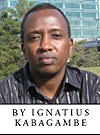“Something Surely Happened” ended up being agreeable as a title for a piece Sunday Vision extracted from Steven Kinzer’s bestseller on Rwanda President Paul Kagame. A Thousand Hills, Rwanda’s Rebirth and the Man Who Dreamed it is the book, on the market for over a year now, contrary to the ‘just released’ tag given it by Uganda’s leading Sunday paper.


"Something Surely Happened” ended up being agreeable as a title for a piece Sunday Vision extracted from Steven Kinzer’s bestseller on Rwanda President Paul Kagame. A Thousand Hills, Rwanda’s Rebirth and the Man Who Dreamed it is the book, on the market for over a year now, contrary to the ‘just released’ tag given it by Uganda’s leading Sunday paper.
The extract carried a befitting intro that read: "…Kagame’s lost childhood, withdrawn teenage years and his determination to fight discrimination against Rwandans in exile as well as rebuild a motherland he only imagined”. But the three accompanying photos had totally nothing to do with the story.
One is of about 20 bodies of dead children laid on some ground said by the caption to be Kibeho camp in 1995. The other shows Kagame and his wife Jeannette in the lead of other VIPs including presidents Yoweri Museveni and
Thabo Mbeki, ready to place wreaths on a mass grave at the Kigali Genocide Memorial in Gisozi. The third is a scene acted in the Sometimes in April Rwanda Genocide film by Raoul Peck, depicting genocide targets wrestling with UNAMIR peace keepers in a desperate effort to escape from their hunters.
The description of Kagame’s youth and the tough challenges of the armed struggle he was to later lead not withstanding, as a whole the book is a celebration in terms of what both Rwanda and its president are achieving today.
It is a narration of a forced journey out of mother country in 1959, to living in destitution for more than three decades, and how despite the hardships a return trip was successfully planned and executed. It is a story of a nation born again, now being shepherded by a man whose dream to reverse the unfortunate history of his people came true.
The bulk of the book is tales of post-genocide ethnic reconciliation, reconstruction of the national economy, political empowerment of the formerly marginalized groups such as women, and accelerated social-economic development.
Yet there is absolutely nothing celebratory about the pictures. They were outrageously out of tune. Images of unburied corpses of innocent children, leaders in a reflective solemn mood on Genocide commemoration day and a heart stopping recreation by actors of the 1994 tragic times; two pictures shot purposely to share Genocide memories with the rest of the world and one which is a sharp reminder that the national army had not yet built sufficient capacity to prevent genocide related massacres a year after the pogrom.
These were three pictures related to the Genocide, printed to strengthen the message in the story from this introductory part of the book – which does not mention the word genocide anywhere in it! For this amateurish journalism to be allowed at one of the best media outlets in the region, indeed something unusual must have happened in the newsroom.
The sloppiness was simply too bold. The times are inharmonious – photos taken after 1994, matched with events preceding 1990. Whereas images are supposed to have meaning in the context of the text to complement each other, these particular ones blatantly told a different story.
The situation they implied was unashamedly unfair and inaccurate. They grossly misrepresented both the content and tone of the piece. Instead of the images combining with other elements in the story to make facts relatable to the reader, they most likely had the effect of confusing the mind.
This conclusion is arrived at basing on realizing that objectivity and narrative as photojournalism merits were mercilessly ignored.
So what exactly went wrong? Sunday Vision Editor David Mukholi admitted what they did was unprofessional.
When pressed for explanation he simply put it down to a bad day at the office. He said such occurrences were not very rare in a newsroom, pointing to a similar mishap they had experienced two weeks earlier, which earned the paper bashing from a foreign diplomatic mission.
Indeed Rwanda’s own embassy in Kampala lodged a verbal complaint when the allegedly Kibeho photo, one of the wrong three, was published in the New Vision on April 16 alongside a letter to the editor from one Abel Duhimbaze claiming the 1994 Genocide was triggered by the plane crash.
Misnomers of such magnitude have potential to cause diplomatic rows. Thank God Kigali and Kampala have done a commendable job restoring their friendly relations, a good topic next time, which will involve talking to politicians and diplomats.
The argument today is purely journalistic. Below is a short but sharp comment from one of our own.
The East African Kampala Bureau Chief Michael Wakabi, a Ugandan journalist whose career stretches over 25 years and a host of newsrooms in the region, thought the mismatch of photos and text was work of an incompetent sub-editor.
"That must have been done by a lazy, young and errant sub-editor. It was failure of a newsroom in the absence of the editor. I am not surprised it happened on a weekend because it is common for editors to be off on Saturdays.”
Editors are that vital to the proper functioning of newsrooms. When they are off duty, stand-ins should be technically as good or else something wrong will surely happen.


